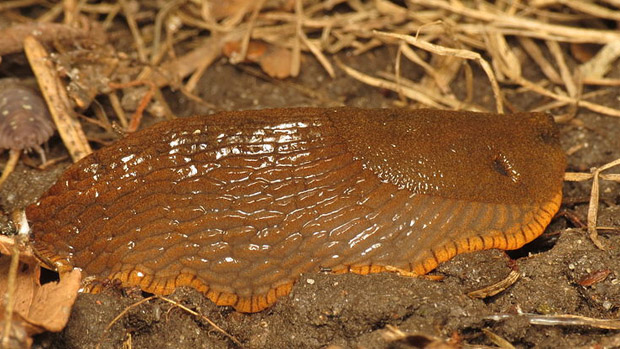British gardens face 15cm Spanish 'superslug' invasion
Spanish slugs have an 'aggressive breeding cycle' and eat everything from faeces to each other

Gardeners in Britain face a battle against 15cm Spanish "superslugs" following the warmer than average winter, according to experts.
Dr Ian Bedford, head of entomology at John Innes Centre in Norwich, discovered the new species in the UK in 2012 and is predicting an explosion in their population this year.
The Spanish slug, or Arion vulgaris, eats not only plants but dog excrement, dead animals and its own kind, and its "aggressive breeding cycle" means numbers can multiply quickly, says the BBC.
The Week
Escape your echo chamber. Get the facts behind the news, plus analysis from multiple perspectives.

Sign up for The Week's Free Newsletters
From our morning news briefing to a weekly Good News Newsletter, get the best of The Week delivered directly to your inbox.
From our morning news briefing to a weekly Good News Newsletter, get the best of The Week delivered directly to your inbox.
According to the Slugwatch website, set up by Bedford, Spanish slugs can self-fertilise and lay around 400 eggs a year. They also produce "huge amounts of mucus" that repels predators.
They vary in colour from bright orange to reddish brown and can grow to between 8cm and 15cm when they have reached maturity.
"It's been estimated that a cubic metre of a garden in the UK could accommodate up to 200 slugs, each of which can have up to 200 offspring," says Bedford.
"They usually survive the winter in our gardens as eggs. Without a cold snap, it's fair to say that slug numbers, especially the invading Spanish slug, which can lay up to 400 eggs, will escalate this year."
A free daily email with the biggest news stories of the day – and the best features from TheWeek.com
It is thought that the species came to the UK on imported produce such as fruit and vegetables, bare root trees or potted plants.
The Arion vulgaris is different to another kind of Spanish slug called the Arion Flagellus, which was first identified in the UK 60 years ago. Known as the Spanish stealth slug, the Arion Flagellus grows to 10cm and has a reproductive capacity of around 350 eggs a year.
The Daily Telegraph has produced a 30-day "plan of attack" for gardeners, which includes rotovating soil to expose slugs and eggs to hedgehogs and birds, heading out at night with a torch to collect and remove slugs and greasing the rim of plant pots with Vaseline and salt.
-
 The Trump administration says it deports dangerous criminals. ICE data tells a different story.
The Trump administration says it deports dangerous criminals. ICE data tells a different story.IN THE SPOTLIGHT Arrest data points to an inconvenient truth for the White House’s primary justification for its ongoing deportation agenda
-
 Ex-FBI agents sue Patel over protest firing
Ex-FBI agents sue Patel over protest firingspeed read The former FBI agents were fired for kneeling during a 2020 racial justice protest for ‘apolitical tactical reasons’
-
 The real tragedy that inspired ‘Hamlet,’ the life of a pingpong prodigy and the third ‘Avatar’ adventure in December movies
The real tragedy that inspired ‘Hamlet,’ the life of a pingpong prodigy and the third ‘Avatar’ adventure in December moviesThe Week Recommends This month’s new releases include ‘Hamnet,’ ‘Marty Supreme’ and ‘Avatar: Fire and Ash’
-
 Home Office worker accused of spiking mistress’s drink with abortion drug
Home Office worker accused of spiking mistress’s drink with abortion drugSpeed Read Darren Burke had failed to convince his girlfriend to terminate pregnancy
-
 In hock to Moscow: exploring Germany’s woeful energy policy
In hock to Moscow: exploring Germany’s woeful energy policySpeed Read Don’t expect Berlin to wean itself off Russian gas any time soon
-
 Were Covid restrictions dropped too soon?
Were Covid restrictions dropped too soon?Speed Read ‘Living with Covid’ is already proving problematic – just look at the travel chaos this week
-
 Inclusive Britain: a new strategy for tackling racism in the UK
Inclusive Britain: a new strategy for tackling racism in the UKSpeed Read Government has revealed action plan setting out 74 steps that ministers will take
-
 Sandy Hook families vs. Remington: a small victory over the gunmakers
Sandy Hook families vs. Remington: a small victory over the gunmakersSpeed Read Last week the families settled a lawsuit for $73m against the manufacturer
-
 Farmers vs. walkers: the battle over ‘Britain’s green and pleasant land’
Farmers vs. walkers: the battle over ‘Britain’s green and pleasant land’Speed Read Updated Countryside Code tells farmers: ‘be nice, say hello, share the space’
-
 Motherhood: why are we putting it off?
Motherhood: why are we putting it off?Speed Read Stats show around 50% of women in England and Wales now don’t have children by 30
-
 Anti-Semitism in America: a case of double standards?
Anti-Semitism in America: a case of double standards?Speed Read Officials were strikingly reluctant to link Texas synagogue attack to anti-Semitism